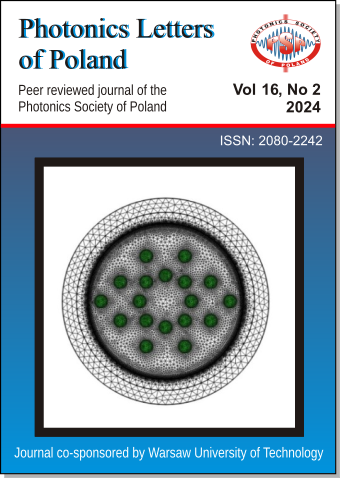Considering microplastic pollution and rapid accumulation of the pollutants in the environment, it is needed to have detailed information about the particles to describe their origin to take precautions. However, taking clear measurements and analyzing them can be challenging regarding the environment. In this study, as input parameters of optical scattering, particle size and material, excitation laser and refractive index of the medium and their effects are investigated. The effect of the medium is presented as Mie resonances for red, green, and blue lights. Machine learning results show that angle differences can be used for particle characterization at different environments.
Full Text: PDF
References
Q. Zhang, E. G. Xu, J. Li, Q. Chen, L. Ma, E. Y. Zeng, and H. Shi, "A Review of Microplastics in Table Salt, Drinking Water, and Air: Direct Human Exposure", Environ Sci Technol 54, 3740 (2020). CrossRef L.M. Hernandez, E.G. Xu, H.C.E. Larsson, R. Tahara, V.B. Maisuria, and N. Tufenkji, "Plastic Teabags Release Billions of Microparticles and Nanoparticles into Tea", Environ Sci Technol 53, 12300 (2019). CrossRef C.K. Chen, J. Zhang, A. Bhingarde, T. Matotek, J. Barrett, B.D. Hardesty, M.M. Banaszak Holl, and B.L. Khoo, "A portable purification system for the rapid removal of microplastics from environmental samples", Chem Eng J., 428, 132614 (2022). CrossRef A. H. Iri, M. H. A. Shahrah, A. M. Ali, S. A. Qadri, T. Erdem, I. T. Ozdur, and K. Icoz, "Optical detection of microplastics in water", ESPR., 28, 63860 (2021). CrossRef C.F. Bohren and D.R. Huffman, Absorption and scattering of light by small particles (New York, Wiley, 1983). CrossRef H.C. van de Hulst, Light scattering by small particles (New York, Dover Publications, 1981). CrossRef "sinanngenc/miemtlb: Mie scattering calculations by MATLAB," (March 20, 2024). DirectLink S. Genc, K. Icoz, and T. Erdem, "Numerical analysis and experimental verification of optical scattering from microplastics", R Soc Open Sci., 10 (2023). CrossRef S. Genc, T. Erdem, and K. Icoz, "Size, material type, and concentration estimation for micro-particles in liquid samples", Sensors and Actuators: A. 370 (2024). CrossRef "Refractive index of H2O, D2O (Water, heavy water, ice)" (March 20, 2024). DirectLink S. Liu, Z. Deng, J. Li, J. Wang, N. Huang, R. Cui, Q. Zhang, J. Mei, W. Zhou, C. Zhang, Q. Ye, J. Tian, "Measurement of the refractive index of whole blood and its components for a continuous spectral region", J Biomed Opt., 24(3), 1 (2019). CrossRef "Refractive index of C3H5(OH)3 (Glycerol)" (March 20, 2024). DirectLink J.E.F. Rubio, J.M. Arsuaga, M. Taravillo, V.G. Baonza, and M. Cáceres, "Refractive index of benzene and methyl derivatives: temperature and wavelength dependencies", Exp Therm Fluid Sci., 28, 887(2004). CrossRef "Refractive index of SiO2 (Silicon dioxide, Silica, Quartz)" (March 20, 2024). DirectLink "Physical properties of plastics" (March 20, 2024). DirectLink "Refractive Index of Polymers by Index," (March 20, 2024). DiectLink H. A. Gaur and H. De Vries, "On the refractive indexes and birefringence of nylon 6 yarns as a function of draw ratio and strain", Journal of Polymer Science: Polymer Physics Edition 13, 835 (1975). CrossRef "Refractive index of (C8H8)n (Polystyrene)" (March 20, 2024). DirectLink "Refractive index of (C10H8O4)n (Polyethylene terephthalate)" (March 20, 2024). DirectLink M. Z. Joharestani, C. Cao, X. Ni, B. Bashir, and S. Talebiesfandarani, "PM2.5 Prediction Based on Random Forest, XGBoost, and Deep Learning Using Multisource Remote Sensing Data", Atmosphere, 10(7), 373 (2019). CrossRef J.L. Speiser, M.E. Miller, J. Tooze, and E. Ip, "A comparison of random forest variable selection methods for classification prediction modeling", Expert Syst Appl., 134, 93 (2019). CrossRef How to Cite
How to Cite
[1]
S. Genc, “Effect of medium refractive index on microparticle characterization by optical scattering”, Photonics Lett. Pol., vol. 16, no. 2, pp. 19–21, Jun. 2024.
License Authors retain copyright and grant the journal right of first publication with the work simultaneously licensed under a Creative Commons Attribution License that allows others to share the work with an acknowledgement of the work's authorship and initial publication in this journal. Authors are able to enter into separate, additional contractual arrangements for the non-exclusive distribution of the journal's published version of the work (e.g., post it to an institutional repository or publish it in a book), with an acknowledgement of its initial publication in this journal. Authors are permitted and encouraged to post their work online (e.g., in institutional repositories or on their website) prior to and during the submission process, as it can lead to productive exchanges, as well as earlier and greater citation of published work (See The Effect of Open Access).
留言 (0)